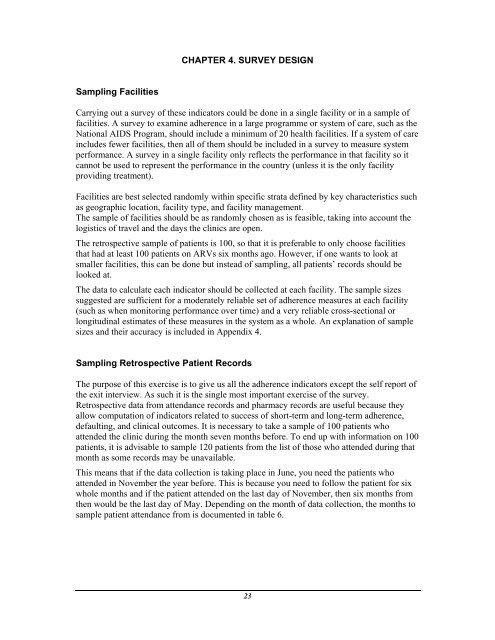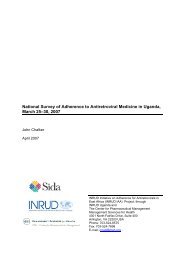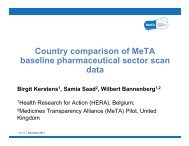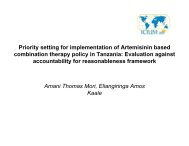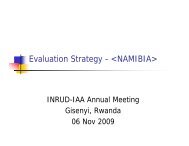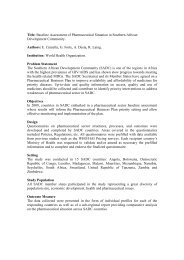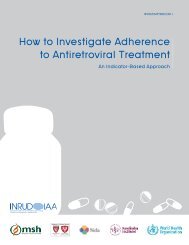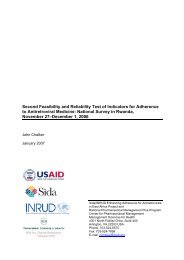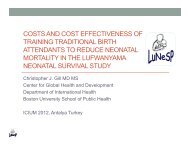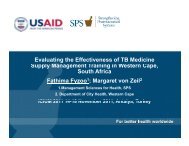How to investigate Adherence to Antiretroviral Treatment ... - INRUD
How to investigate Adherence to Antiretroviral Treatment ... - INRUD
How to investigate Adherence to Antiretroviral Treatment ... - INRUD
You also want an ePaper? Increase the reach of your titles
YUMPU automatically turns print PDFs into web optimized ePapers that Google loves.
CHAPTER 4. SURVEY DESIGN<br />
Sampling Facilities<br />
Carrying out a survey of these indica<strong>to</strong>rs could be done in a single facility or in a sample of<br />
facilities. A survey <strong>to</strong> examine adherence in a large programme or system of care, such as the<br />
National AIDS Program, should include a minimum of 20 health facilities. If a system of care<br />
includes fewer facilities, then all of them should be included in a survey <strong>to</strong> measure system<br />
performance. A survey in a single facility only reflects the performance in that facility so it<br />
cannot be used <strong>to</strong> represent the performance in the country (unless it is the only facility<br />
providing treatment).<br />
Facilities are best selected randomly within specific strata defined by key characteristics such<br />
as geographic location, facility type, and facility management.<br />
The sample of facilities should be as randomly chosen as is feasible, taking in<strong>to</strong> account the<br />
logistics of travel and the days the clinics are open.<br />
The retrospective sample of patients is 100, so that it is preferable <strong>to</strong> only choose facilities<br />
that had at least 100 patients on ARVs six months ago. <strong>How</strong>ever, if one wants <strong>to</strong> look at<br />
smaller facilities, this can be done but instead of sampling, all patients’ records should be<br />
looked at.<br />
The data <strong>to</strong> calculate each indica<strong>to</strong>r should be collected at each facility. The sample sizes<br />
suggested are sufficient for a moderately reliable set of adherence measures at each facility<br />
(such as when moni<strong>to</strong>ring performance over time) and a very reliable cross-sectional or<br />
longitudinal estimates of these measures in the system as a whole. An explanation of sample<br />
sizes and their accuracy is included in Appendix 4.<br />
Sampling Retrospective Patient Records<br />
The purpose of this exercise is <strong>to</strong> give us all the adherence indica<strong>to</strong>rs except the self report of<br />
the exit interview. As such it is the single most important exercise of the survey.<br />
Retrospective data from attendance records and pharmacy records are useful because they<br />
allow computation of indica<strong>to</strong>rs related <strong>to</strong> success of short-term and long-term adherence,<br />
defaulting, and clinical outcomes. It is necessary <strong>to</strong> take a sample of 100 patients who<br />
attended the clinic during the month seven months before. To end up with information on 100<br />
patients, it is advisable <strong>to</strong> sample 120 patients from the list of those who attended during that<br />
month as some records may be unavailable.<br />
This means that if the data collection is taking place in June, you need the patients who<br />
attended in November the year before. This is because you need <strong>to</strong> follow the patient for six<br />
whole months and if the patient attended on the last day of November, then six months from<br />
then would be the last day of May. Depending on the month of data collection, the months <strong>to</strong><br />
sample patient attendance from is documented in table 6.<br />
23


